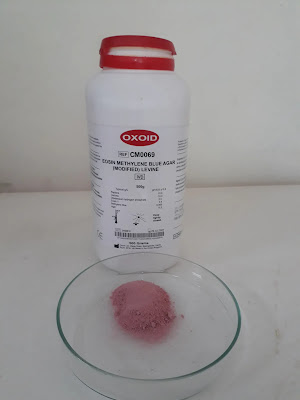CHEMICAL PRODUCT IDENTIFICATION
Contents
hide
- Product: Eosin-methylene blue agar.
- Signal Word: N/A.
- A Vibrant Solution – Eosin-Methylene Blue Agar SDS!
HAZARDS IDENTIFICATION
- According to GHS classifications for the Hazard Communication Standard, this chemical is not deemed dangerous. All laboratory substances should be handled with care.
- Pathogenic microbes may be able to grow on this material. When cultivating, use suitable aseptic procedures. Sterilization is required before disposing of cultures.
COMPOSITION, INFORMATION ON INGREDIENTS
| Component Name | CAS Number | Formula | Formula Weight | Concentration |
|---|---|---|---|---|
| Agar, bacteriological grade | 9002-18-0 | Unspecified | Unspecified | 37.5% |
| Peptone (source: bovine) | 91079-38-8 | Unspecified | Unspecified | 27.8% |
| Lactose monohydrate | 64044-51-5 | C12H22O11•H2O | 360.31 | 13.9% |
| Sucrose | 57-50-1 | C12H22O11 | 342.31 | 13.9% |
| Potassium phosphate dibasic | 7758-11-4 | K2HPO4 | 174.18 | 5.5% |
| Eosin Y | 17372-87-1 | C20H6Br4Na2O5 | 691.91 | 1.1% |
| Methylene blue trihydrate | 7220-79-3 | C16H18ClN3S•3H2O | 373.90 | 0.2% |
- Synonyms: EMB Agar.
FIRST-AID MEASURES
- If you feel unwell, contact a doctor.
- If inhaled: Remove the victim to fresh air and keep them at rest in a breathing-friendly position.
- If in eyes: Rinse carefully for a few minutes with water. If contact lenses are present and simple to remove, do so. Rinsing continues.
- If on the skin: Wash with plenty of water.
- If swallowed: Rinse mouth. Call a doctor if you feel unwell.
FIRE-FIGHTING MEASURES
- Nonflammable solid.
- When heated to decomposition, it may emit toxic fumes.
- In case of fire: Use a tri-class dry chemical fire extinguisher.
ACCIDENTAL RELEASE MEASURES
- Clean up any spills & sanitize any equipment that has already been used for culturing. Place it in the garbage. For additional details, refer to Sections 8 and 13.
HANDLING & STORAGE
- Moisture sensitive. Store in a cool, dry place within a chemical safety bag.
EXPOSURE CONTROLS, PERSONAL PROTECTION
- Avoid making eye contact. When working with culture media, employ sterile procedures. After handling, carefully wash your hands.
PHYSICAL & CHEMICAL PROPERTIES
- Appearance: Pink/violet powder. Malt-like odor.
- Soluble: Forms a gel with boiling water.
- Biological use: Differential bacterial media (gram-negative bacteria).
- To prepare culture media: Mix 36 grams per liter of water. Sterilize before use.
STABILITY & REACTIVITY
- The product that is stable & safe.
- Good shelf life if properly stored.
TOXICOLOGICAL INFORMATION
- Acute effects: N.A.
- Chronic effects: N.A.
- Target organs: N.A.
- N.A. for ORL-RAT LD50.
- LC50 for IHL-RAT: N.A.
- LD50 for SKN-RBT: N.A.
ECOLOGICAL INFORMATION
- Data is not yet available.
DISPOSAL CONSIDERATIONS
- Please check all applicable federal, state, & local laws before moving forward.
- Disposal Method Sugession: Sterilize prior to disposal.
TRANSPORT INFORMATION
- Shipping name: Not regulated. Hazard class: N/A. UN number: N/A.
REGULATORY INFORMATION
- Not listed.
OTHER INFORMATION
This Eosin-Methylene Blue Agar SDS is intended as a piece of advice & is based on data & tests that are likely to be reliable. I don’t guarantee the data’s correctness or completeness & I’m not responsible for any resulting losses. The information is only being provided for your review, research, & verification. I DO NOT ASSUME RESPONSIBILITY AND EXPRESSLY DISCLAIM LIABILITY FOR LOSS, DAMAGE, OR EXPENSE RESULTING FROM OR IN ANY WAY CONNECTED WITH THE HANDLING, STORAGE, USE, OR DISPOSAL OF THIS PRODUCT FOR THE FOREGOING AND OTHER REASONS.

CONCLUSION
Eosin-methylene blue agar is a valuable tool for the identification & differentiation of pathogenic microorganisms. This differential media has been used for many years as a reliable & accurate method to identify bacteria that can cause human illness. The combination of the two dyes eosin & methylene blue allows for the detection of colonies with different morphologies and the identification of different bacterial species. EMB agar has been used to identify bacteria such as Salmonella, Shigella, Escherichia coli, and Staphylococcus aureus. The accuracy & reliability of this agar provide a significant advantage in the identification of pathogens and can be used in both clinical & research settings.
One must read and follow Eosin-Methylene Blue Agar SDS while handling this stuff.
